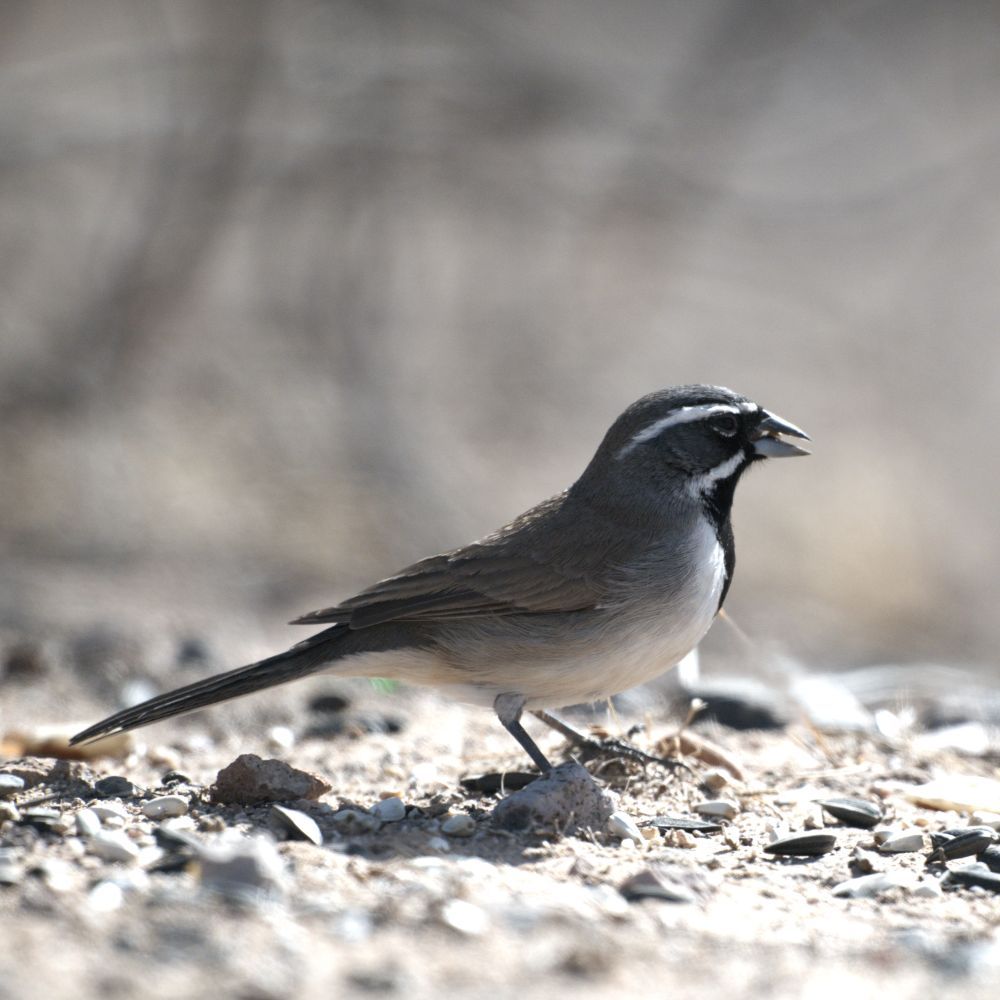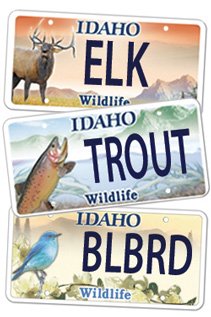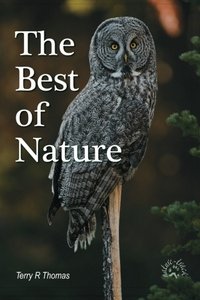Sparrows

©Terry R. Thomas/www.nature-track.com
My favorite sparrow is the feisty black-throated sparrow of southern Arizona. He is a handsome boy.
I clearly remember the day when my wife called me at work shortly after she took up birding as a hobby. She was excited to describe a bird that was visiting our backyard feeder. Small and brown, she was sure it was a sparrow, but she had never seen this handsome bird before. After patiently listening to her description, I burst her bubble by telling her that her amazing “discovery” was the male house sparrow, possibly the most common and invasive bird on this continent, if not the planet.
In the world of non-birders, the word, sparrow, is a catch-all meaning any little bird that isn’t a robin, duck, or hawk, what we used to call, “little brown jobs” or LBJs. Learn a little about birds and birding though, and “sparrow” suddenly becomes a complex group of birds, some of which can be devilish to identify.
The sparrow group consists of New World sparrows which are members of the Passerellidae family and Old World sparrows which are members of the family Passeridae. Each family has 43 species. However, the Old World sparrows are represented by only eight genera, while there are 30 genera in the New World family.
There is a HUGE “but” here. The bird taxonomy world has been in an upheaval for at least a dozen years and you can find a wide variety of numbers and even some new families when it comes to sparrows. I am sticking with Cornell University’s All About Birds website as my primary source and just hope they are even close to correct.
So, what makes a sparrow a sparrow? First, they are mostly small. One species in the Old World is over seven inches long, but most are five to six inches, some even smaller. As a group, most are plainly patterned on the body, often with the usual mottled whites, browns, and blacks. However, when it comes to dressing for success, many sparrows place all their attention on ornamentation around the head and neck. My favorite sparrow, the black-throated sparrow, sports a striking combination of gray cap and cheek separated by a white line and another white line separating the cheek from the black throat. Many other sparrows have handsome head patterns as well.
Sparrows are seed eaters (they do consume some insects, especially when young and growing) and have developed two features to help them with this particular diet. First, they have a conical bill, something like a short pointed ice cream cone. It is stout and perfect for cracking open seeds. In addition, they have a bone in their tongue which stiffens it, making it more effective for removing and manipulating seeds.
Sparrows can be found in just about any type of habitat from deserts to the near Arctic, with some specializing in particular environments. The swamp sparrow and sagebrush sparrow, for instance, both have specific habitat requirements as noted by their names. Others are wide-ranging generalists, and some get along well with human development.
Of all the North American sparrows, the song sparrow is by far the most widely distributed (house sparrows do not count as they are Old World sparrows). This crooner is a bit nondescript, but makes up for it with a variety of songs, depending on which part of the continent you are on.
Most of the North American sparrows have “sparrow” in their name. However, it might surprise you to find out that lark buntings, juncos, and even towhees are considered members of the sparrow family (of course, that depends upon the source you are referencing).
Sparrows add so much variety and interest to our landscape that it is surprising more people don’t know one from another. I get it though. After years of trying, we still misidentify or are stumped by LBJs that we know are sparrows, but dang, we just can’t identify them.
Help Idaho Wildlife
When we traveled across the state in October 2017, we visited most of the Idaho Department of Fish and Game wildlife management areas. Most of the vehicles we saw using the wildlife management areas did not have wildlife plates. Buying wildlife plates is a great way for non-hunters and hunters alike to support wildlife-based recreation like birding.
C'mon folks, let's help Idaho's wildlife by proudly buying and displaying a wildlife license plate on each of our vehicles!
See below for information on Idaho plates. Most states have wildlife plates so if you live outside Idaho, check with your state's wildlife department or vehicle licensing division for availability of state wildlife plates where you live.
And tell them that you heard about it from Nature-track.com!

Wildlife License Plates
Great news! as of 2024, there are three NEW designs for license plates. They still are bluebird, cutthroat trout and elk, but they are beautiful.
Idaho Wildlife license plates provide essential funding that benefits the great diversity of native plants and wildlife that are not hunted, fished or trapped—over 10,000 species or 98% of Idaho’s species diversity. Game species that share the same habitats (such as elk, deer, antelope, sage-grouse, salmon, trout) also benefit from these specialty plates.
No state tax dollars are provided for wildlife diversity, conservation education and recreation programs. Neither are any revenues from the sale of hunting or fishing licenses spent on nongame species. Instead, these species depend on direct donations, federal grants, fundraising initiatives—and the Idaho Wildlife license plates.
Both my vehicles have Bluebird Plates. I prefer the bluebird because the nongame program gets 70 percent of the money from bluebird plates, but only 60 percent of the money from elk and trout plates - 10 percent of the money from elk plates supports wildlife disease monitoring and testing programs (to benefit the livestock industry) and 10 percent from cutthroat plates supports non-motorized boat access.
Incidentally, in 2014, the Idaho Legislature denied the Department of Fish and Game the ability to add new plates or even to change the name of the elk and cutthroat plates (very specific) to wildlife and fish plates, a move that would have allowed for changing images occasionally and generating more revenue. It would seem that they believe that we Idahoans don't want a well funded wildlife program.
I think it is time we let the Legislature know that Idahoan support wildlife funding and that we would like to see these generic plates come to fruition.

"WOW. What a phenomenal piece you wrote. You are amazing." Jennifer Jackson
That is embarrassing, but actually a fairly typical response to my nature essays. Since The Best of Nature is created from the very best of 16 years of these nature essays published weekly in the Idaho Falls Post Register (online readership 70,000), it is a fine read. It covers a wide variety of topics including humorous glimpses of nature, philosophy, natural history, and conservation. Readers praise the style, breadth of subject matter and my ability to communicate complex and emotional topics in a relaxed and understandable manner.
Everyone can find something to love in this book. From teenagers to octogenarians, from the coffee shop to the school room, these nature essays are widely read and enjoyed.
Some of the essays here are my personal favorites, others seemed to strike a chord with readers. Most have an important message or lesson that will resonate with you. They are written with a goal to simultaneously entertain and educate about the wonderful workings of nature. Some will make you laugh out loud and others will bring a tear to the eye and warm your heart.
Readers Write:
"You hit a home run with your article on, Big Questions in Nature. It should be required reading for everyone who has lost touch with nature...great job!" Joe Chapman
"We enjoyed your column, Bloom Where Planted. Some of the best writing yet. The Post Register is fortunate to have your weekly columns." Lou Griffin.
To read more and to order a copy, click here or get the Kindle version
Copies are also available at:
Post Register
Island Park Builders Supply (upstairs)
Barnes and Noble in Idaho Falls
Harriman State Park, Island Park
Museum of Idaho
Valley Books, Jackson Wyoming
Avocet Corner Bookstore, Bear River National Wildlife Refuge, Brigham City, Utah
Craters of the Moon National Monument Bookstore, Arco, Idaho